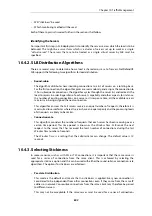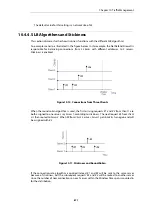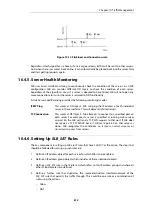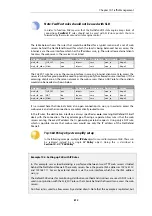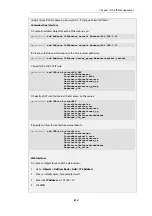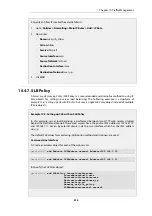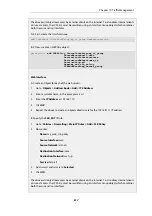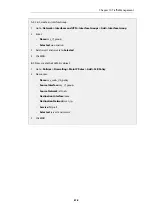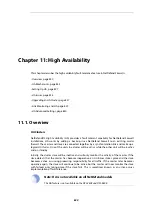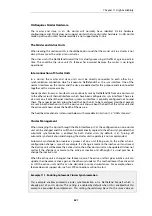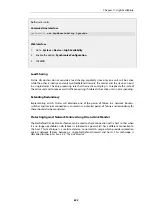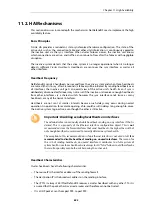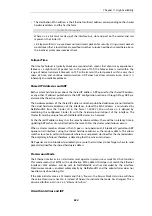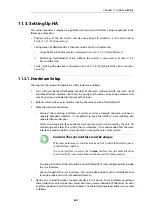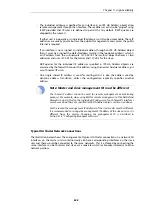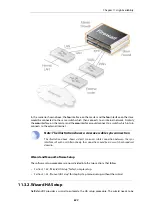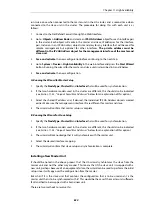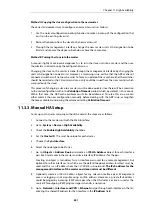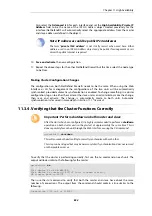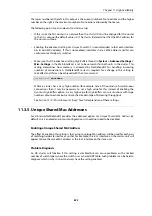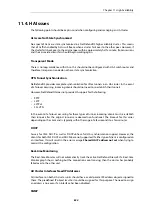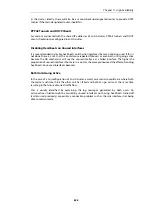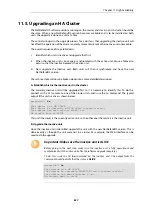
11.2. HA Mechanisms
This section discusses in more depth the mechanisms NetDefendOS uses to implement the high
availability feature.
Basic Principles
D-Link HA provides a redundant, state-synchronized hardware configuration. The state of the
active unit, such as the connection table and other vital information, is continuously copied to
the inactive unit via the
sync
interface. When cluster failover occurs, the inactive unit knows
which connections are active, and traffic can continue to flow after the failover with negligible
disruption.
The inactive system detects that the active system is no longer operational when it no longer
detects sufficient
Cluster Heartbeats
. Heartbeats are sent over the
sync
interface as well as all
other interfaces.
Heartbeat Frequency
NetDefendOS sends 5 heartbeats per second from the active system and when three heartbeats
are missed (that is to say, after 0.6 seconds) a failover will be initiated. By sending heartbeats over
all interfaces, the inactive unit gets an overall view of the active unit's health. Even if
sync
is
deliberately disconnected, failover may not result if the inactive unit receives enough heartbeats
from other interfaces via a shared switch, however the
sync
interface sends twice as many
heartbeats as any of the normal interfaces.
Heartbeats are not sent at smaller intervals because such delays may occur during normal
operation. An operation, for example opening a file, could result in delays long enough to cause
the inactive system to go active, even though the other is still active.
Important: Disabling sending heartbeats on interfaces
The administrator can manually disable heartbeat sending on any interface if that is
desired. This is a property of the Ethernet interface configuration object. This is
not
recommended since the fewer interfaces that send heartbeats, the higher the risk that
not enough heartbeats are received to correctly determine system health.
The exception to this recommendation is if an Ethernet interface is not used at all.
It is
recommended to disable heartbeat sending on unused interfaces.
The reason for
this is that sending heartbeats on unused interfaces contributes to a false picture of
system health since those heartbeats are always lost. A "false" failover could therefore be
the result or possibly even both units becoming the active unit.
Heartbeat Characteristics
Cluster heartbeats have the following characteristics:
•
The source IP is the interface address of the sending firewall.
•
The destination IP is the broadcast address on the sending interface.
•
The IP TTL is always 255. If NetDefendOS receives a cluster heartbeat with any other TTL, it is
assumed that the packet has traversed a router and therefore cannot be trusted.
•
It is a UDP packet, sent from port 999, to port 999.
Chapter 11: High Availability
823
Summary of Contents for NetDefendOS
Page 30: ...Figure 1 3 Packet Flow Schematic Part III Chapter 1 NetDefendOS Overview 30 ...
Page 32: ...Chapter 1 NetDefendOS Overview 32 ...
Page 144: ...Chapter 2 Management and Maintenance 144 ...
Page 284: ...Chapter 3 Fundamentals 284 ...
Page 392: ...Chapter 4 Routing 392 ...
Page 419: ... Host 2001 DB8 1 MAC 00 90 12 13 14 15 5 Click OK Chapter 5 DHCP Services 419 ...
Page 420: ...Chapter 5 DHCP Services 420 ...
Page 573: ...Chapter 6 Security Mechanisms 573 ...
Page 607: ...Chapter 7 Address Translation 607 ...
Page 666: ...Chapter 8 User Authentication 666 ...
Page 775: ...Chapter 9 VPN 775 ...
Page 819: ...Chapter 10 Traffic Management 819 ...
Page 842: ...Chapter 11 High Availability 842 ...
Page 866: ...Default Enabled Chapter 13 Advanced Settings 866 ...
Page 879: ...Chapter 13 Advanced Settings 879 ...

